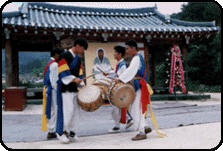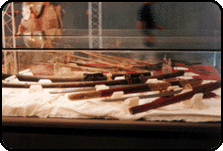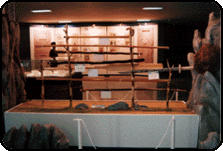Purpose of establishment | Origin of the 24 miliratary arts | Composition
of the 24 military arts |
|
Some of the East's martial
art's originated during the Koguryo Dynasty. The purpose of martial
art's training was to develop a military or disciplined mind and
spirit. It was also used to promote devotion to the welfare of mankind
and make the world a better place. |
|
|
|
|
|
The 24 military arts practiced
in Gyung Dang
These 24 military arts were a compulsory requirement for regular Army troops until the annexation of Korea by Japan in 1910. Even after the annexation, loyal troops fighting for independence relied heavily on the 24 military arts. |
|
|
|
The 24 Military Arts are composed of 1026
techniques and various weapons. Individually each technique is simple
and plain. But when combined the techniques become intricate and
diverse. Included among the 24 military arts weapons are: a
1.35 meter sword weighing 2.5 kilograms, spears ranging from 2 -
6 meters, are both solemn and impressive. These military arts were
developed and refined through scholastic studies and tested in two
wars with neighboring countries. i.e, the Japanese invasion in 1592
and the Manchu invasion in 1636. The 24 military arts are practical
and efficient having been developed, and refined through utilization
in actual combat. |
|
|
"Gyung Dang" originated as an educational system during the Koguryo period. Common youths in every village throughout the country gathered together to study in military arts. Thus they would be prepared to engage in battles in time of war. The present military art "Gyung Dang" is intended to continue this traditional training of the Koguryo period. The training is practical and builds a sound mind and healthy body for daily life. The main training center is located in Kwang-Ju and there are 15 branch schools Seoul, Taegu and Pusan. In the future we plan to establish schools overseas. |
|

 The
"Gyung Dang" dojang has inherited
this spirit of devotion to the welfare of mankind. This spirit has
been expressed since the birth of our nation. During the Koguryo
period martial arts emphasized:independence, self sufficiency and
self-improvement. Gyung Dang's purpose is to cultivate our youths
ability to contribute to the reunification of our divided country,
to build a healthy society and to foster a sound mind and healthy
body. The "Gyung Dang" dojang consists of 24 military
arts based upon on developing national spirit, culture and history.
Through this training we hope to enhance the physical ability and
mental capabilities of our youth.
The
"Gyung Dang" dojang has inherited
this spirit of devotion to the welfare of mankind. This spirit has
been expressed since the birth of our nation. During the Koguryo
period martial arts emphasized:independence, self sufficiency and
self-improvement. Gyung Dang's purpose is to cultivate our youths
ability to contribute to the reunification of our divided country,
to build a healthy society and to foster a sound mind and healthy
body. The "Gyung Dang" dojang consists of 24 military
arts based upon on developing national spirit, culture and history.
Through this training we hope to enhance the physical ability and
mental capabilities of our youth.


